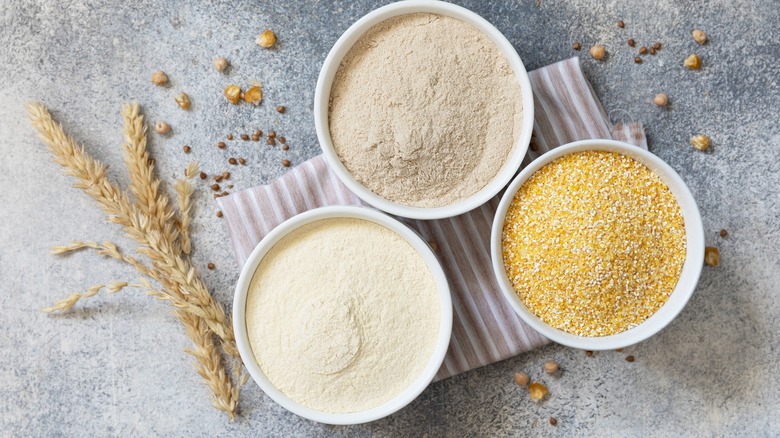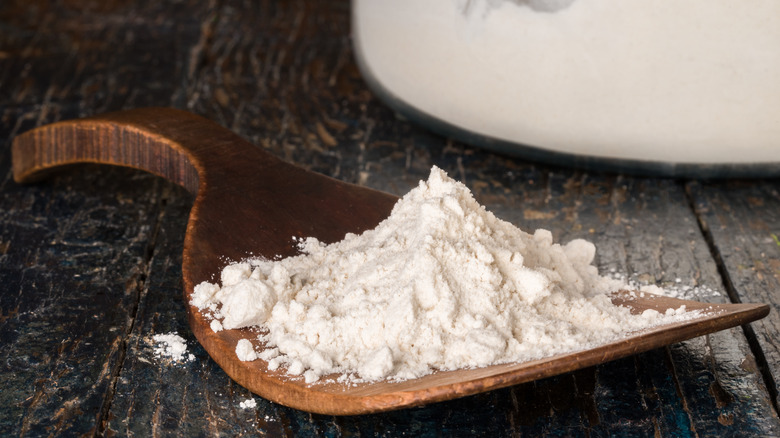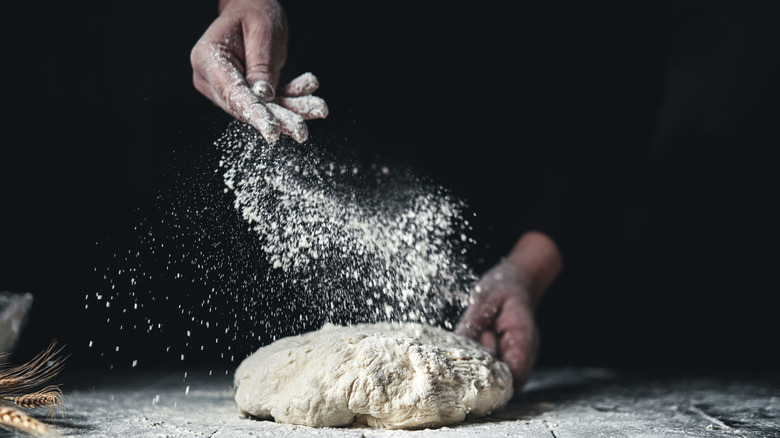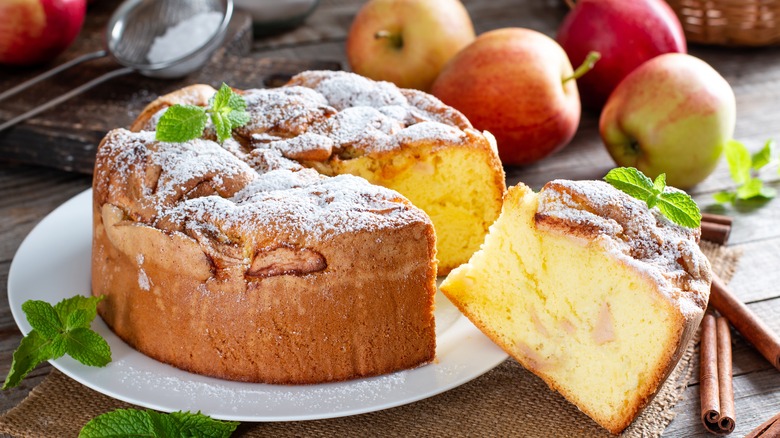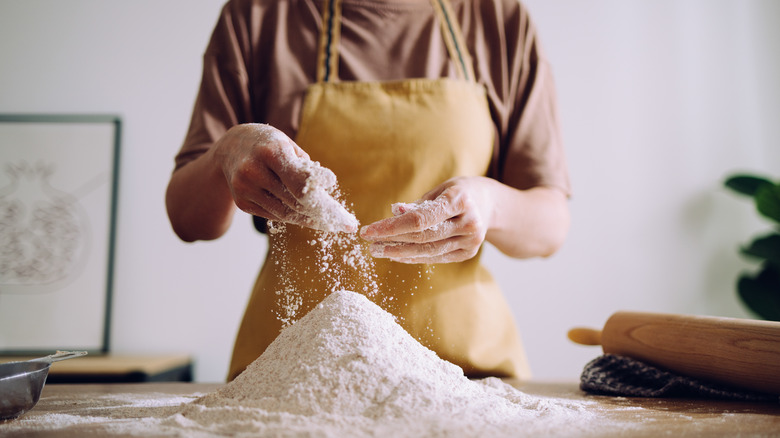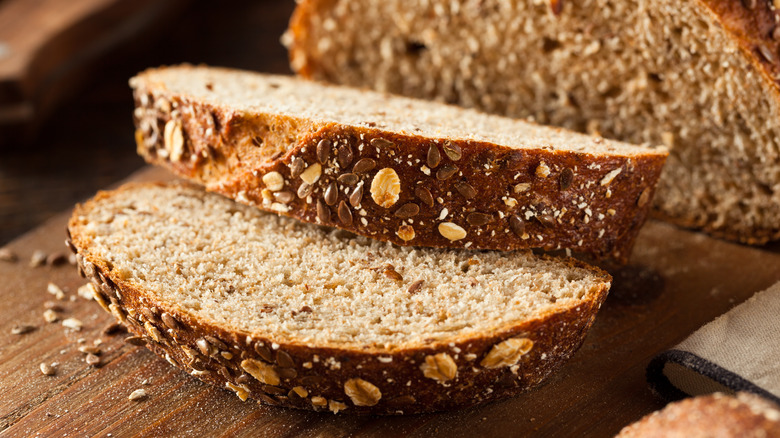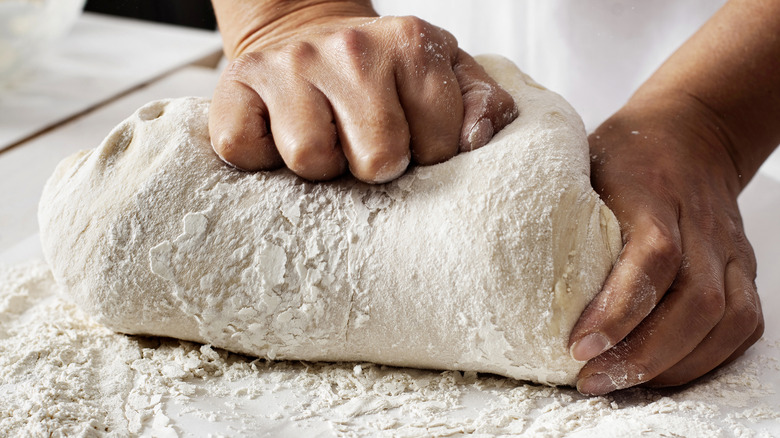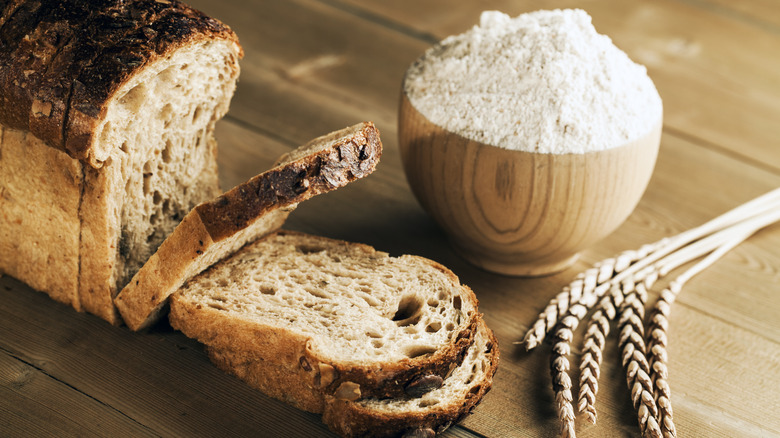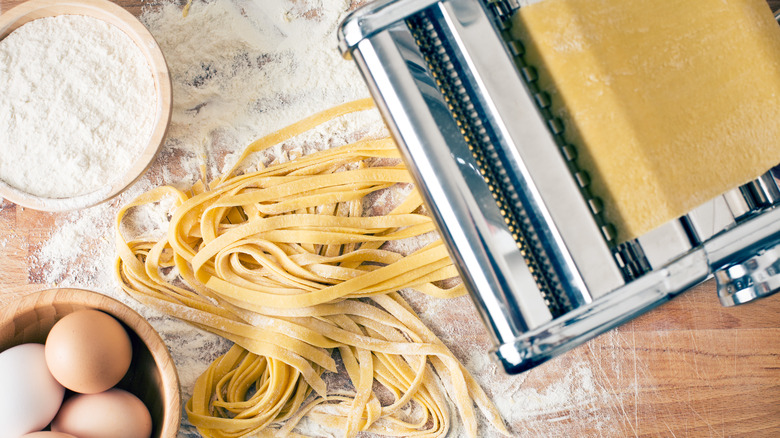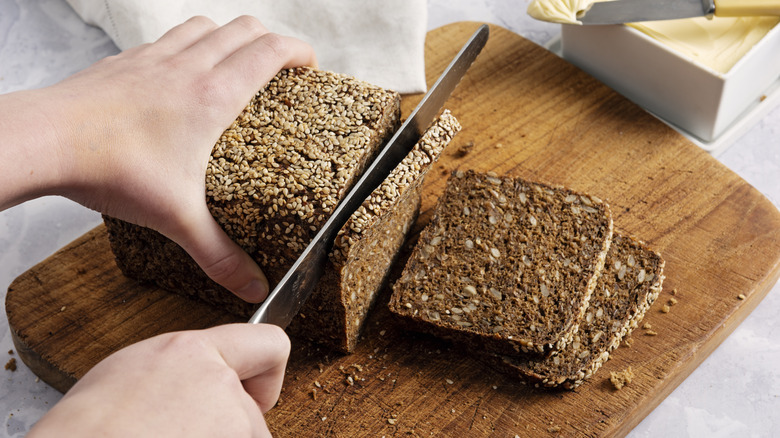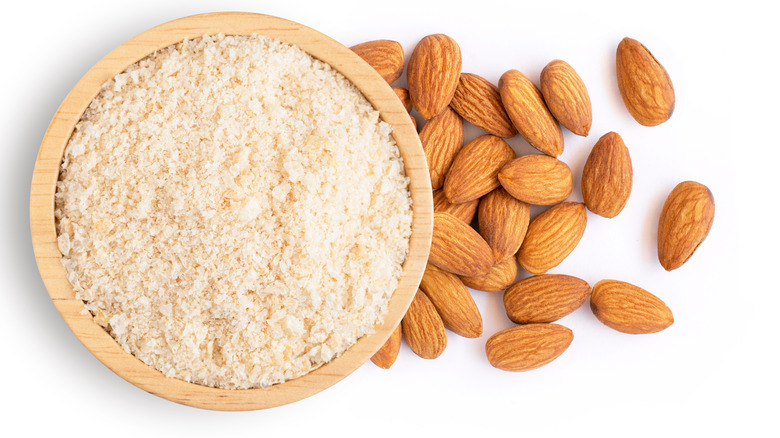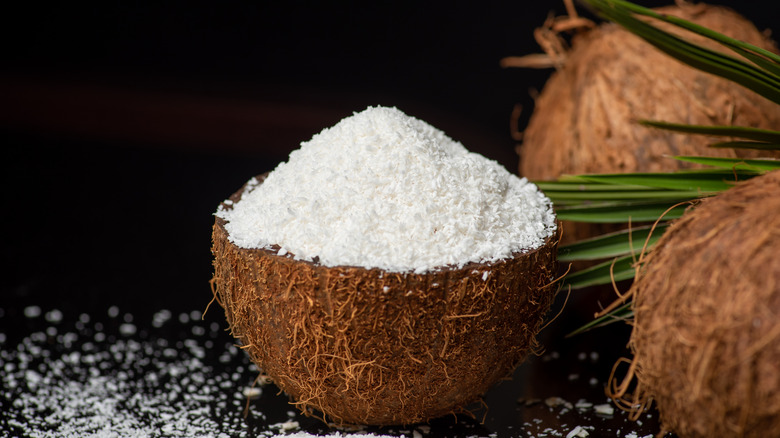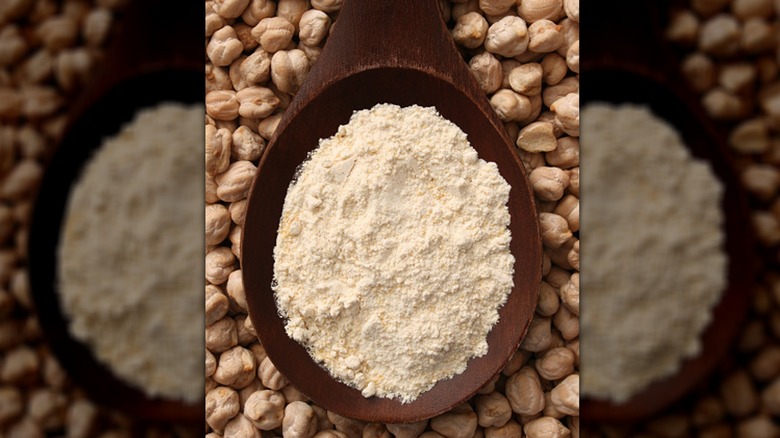12 Types Of Flour And How To Use Them
You already know that flour is an essential ingredient for baking. The finely milled grain gives structure and substance to baked goods from cupcakes to challah bread. If you've ever tried to swap whole wheat flour for pastry flour in your favorite chocolate chip cookie recipe or attempted to use gluten-free flour to make sourdough, you've probably discovered the hard way that not all flour is created equal. Browse the baking aisle of any supermarket and you'll see everything from familiar wheat flour to grain-free varieties like almond, coconut, and chickpea flour. Even flour products sourced from the same grain can yield wildly different results used in the same recipe.
Understanding the qualities of different kinds of flours is one of the best ways to level up your baking skills. From the robust heartiness of rye flour to the airy delicacy of cake flour, each one serves a specific function in your baking repertoire. Learn the differences between 12 types of flour and how to use them for optimal baking success, whether you're a brand-new baker or a seasoned expert.
1. All-Purpose Flour
If you only keep one type of flour in your cupboard, all-purpose flour – sometimes called plain flour — is a pragmatic choice. Made from the milled starchy white center of the wheat kernel, this inexpensive flour has a neutral flavor, pale color, and an enormous variety of uses. In baking, all-purpose flour is the go-to choice for recipes from delicate pastries to hearty bread. Its adaptability comes from its moderate protein content, about 10 to 12%. Combined with liquid, that protein forms gluten strands which give baked goods structure and texture.
In bread making, all-purpose flour provides enough structure to allow the dough to rise and create a well-textured loaf — although you won't get the same super chewy results you will with higher protein flours. This adaptable flour can also be used for thickening sauces and gravies due to its ability to absorb moisture, dissolving into liquid for a velvety thick consistency.
All-purpose flour is available in bleached and unbleached varieties. The primary difference between the two is that bleached flour is treated with chemicals that accelerate the natural aging process of milled grain flour. This chemical process makes the flour softer, more acidic, and lighter in color. While bleached and unbleached flour can be used interchangeably in most recipes, the bleached version will result in baked goods with a lighter texture and more delicate crumb.
2. Bread Flour
Bread flour is a type of flour specifically designed for making yeast-based bread. Made from hard wheat varieties, this flour has a higher protein content than other wheat flour, usually between 12% and 14% by volume. That higher protein content means more stretchy gluten strands to give bread its characteristic structure and chewiness. Those gluten strands stretch and expand to accommodate the carbon dioxide gas produced by yeast fermentation, allowing the dough to rise. And so, bread made with bread flour has a crusty exterior that yields an airy, chewy center perfect for dipping into olive oil or slathering with butter.
Bread flour is best used for recipes leavened with yeast. This includes sourdough bread which uses wild naturally produced yeast, as well as bread made with packaged yeast. If you've been wondering how to create a bakery-style baguette or rustic Italian loaf at home, bread flour might just be the key. Bread flour is also perfect for fluffy dinner rolls and sticky buns. On the other hand, bread flour is not ideal for breads leavened with baking powder or baking soda, like quick bread. Without the yeast to stretch and fill the gluten strands with air bubbles, bread flour creates a tough, dense consistency in recipes like banana bread and pumpkin bread.
3. Cake Flour
Want cakes with a delicate, tender crumb? You need cake flour. Unlike all-purpose and bread flour, cake flour is made from soft wheat varieties, which have a lower protein content, usually around 5 to 8% by volume. This lower protein content minimizes gluten development giving cakes a soft silky texture. It also means the flour contains more starch, a necessary component for thickening batter. Cake flour is usually bleached for a pure white color and even finer, more delicate consistency. The finer consistency allows it to absorb liquid more readily and evenly distribute fat in the batter for moist, velvety smooth cakes and cupcakes.
While you can use all-purpose flour in most cake recipes, the texture will be coarser than the same cake made with cake flour. In recipes like angel food cake and sponge cake, cake flour plays a key role in creating that coveted feather-light crumb that sets those fluffy cakes apart from the crowd. Beyond the cake genre, cake flour has plenty of applications in baking. Use it to make crisp melt-in-your-mouth shortbread cookies, light buttery biscuits, and tender cheesecake crusts.
4. Pastry Flour
Pastry flour falls between all-purpose flour and cake flour in terms of protein content, typically between 9% and 10%. Using pastry flour creates a more tender, delicate crumb than all-purpose flour but offers a bit more structure than cake flour, a balance makes it ideal for –you guessed it — pastry dough. In pastry-based recipes like croissants, pie crust, and strudel, the dough needs to be sturdy enough to shape and stretch while remaining fine enough to bake up into the flaky layers that are hallmarks of good pastry. While you can get similar results by using half cake flour and half all-purpose flour instead, having a bag of pastry flour on hand saves you an extra step of measuring and mixing.
Even if you have no ambition to become the world's next top pastry chef, you may still want to experiment with using pastry flour in other kinds of baked goods. That reduced protein content makes for softer chocolate chip cookies, more tender scones, and cakier muffins. Steer clear of using pastry flour in anything that needs a hearty structure and elasticity like pasta or yeast-leavened breads.
5. Whole Wheat Flour
Whole wheat flour is the darker, more nutrient-dense sibling of all-purpose flour in your pantry. Made by milling the entire wheat kernel, including the bran, germ, and endosperm, whole wheat flour retains more of the good-for-you nutrients found in whole grains. In fact, whole wheat flour has as much as four times the dietary fiber as refined white flour per serving. It's also higher in protein and essential micronutrients like magnesium and phosphorus.
While whole wheat bread provides a more nourishing alternative to other baking flours, it also gives baked goods a distinctly earthy aroma, nutty flavor, and tougher texture. Whole wheat flour works best when it's allowed to take center stage in hearty breads, filling sandwich rolls, and other sturdy baked goods. If you decide to swap the all-purpose flour in a cookie or cake recipe for the whole wheat version, prepare for a significant difference in flavor, consistency, and moisture. Attempts to disguise the powerful taste of whole wheat in delicate layer cakes or decadent cookies may create less-than-desirable results.
6. White Whole Wheat Flour
When you want the nutritional benefits of whole wheat flour without the strong taste, white whole wheat flour is the solution. Like regular whole wheat flour, this flour is unrefined and made from the entire wheat kernel. White whole wheat flour, however, is made from a type of wheat with a lighter color, softer texture, and less noticeable flavor. As a result, this flour has a much milder taste and fragrance than typical whole wheat flour. For bakers who want to add a nutritional boost to their breads and desserts without sacrificing taste, white whole wheat flour makes a suitable compromise. It functions similarly to all-purpose flour in baked goods like yeast bread, sweet bread, muffins, and cookies.
Keep in mind that, while white whole wheat flour is mild and soft compared to other whole wheat flours, it's not going to taste exactly like refined flour in every recipe. Baked goods made with white whole wheat flour may still have a denser texture or slight nuttiness that reminds you of all those nutrients packed inside.
7. Spelt Flour
Spelt flour is milled from spelt, an ancient wheat grain that's been cultivated for thousands of years. This whole-grain flour adds a nutty, acidic flavor to baked goods without the dryness and density of whole wheat. Although high in overall protein, spelt flour has a lower ratio of glutenins to gliadins compared to whole wheat flour. Doughs made with spelt flour have a softer, stickier consistency overall.
If you love the flavor and nutritional benefits of whole wheat bread but don't love how much work it takes to chew, bread made with spelt flour might just prove a happy alternative. The tanginess of spelt flour makes it especially well-suited for sourdough bread. Aside from bread, you can use spelt flour as a more nourishing alternative to all-purpose flour in chocolate chip cookies, where spelt's tartness balances the richness of the chocolate and enhances the sweet aroma of vanilla. The acidity of spelt flour also shines in baked goods made with fresh or dried fruit, like oatmeal raisin cookies, blueberry muffins and pineapple cake.
8. Semolina Flour
Semolina flour is a coarse flour made from durum wheat, one of the hardest types of wheat with high protein content and gluten strength. It has a pale golden color and a gritty texture, which sets it apart from regular wheat flour. These qualities make semolina flour the preferred choice for Italian-style pasta like spaghetti and fettuccini. Pasta made with semolina flour holds up well to boiling and readily absorbs the flavors of a sauce without compromising its toothsome texture and turning to mush. It's also the flour of choice for couscous – fine balls of pasta typical of Mediterranean and Middle Eastern cuisine.
Apart from pasta and couscous, semolina flour is also used to make traditional Middle Eastern desserts including basbousa and halva. The mild sweetness and grainy texture of semolina play a key role in giving the honey-sweetened cake its signature flavor. Semolina flour can also be used in conjunction with all-purpose flour, bread flour, or other wheat flour to give bread and pizza dough a firmer texture and crispier crust.
9. Rye Flour
Rye flour is derived from the rye grain, a strong crop that flourishes even in harsh winter conditions. The hardiness and durability of the rye grain seem to carry over to the taste of its flour. Bold, robust, and pungent, rye creates baked goods with a dense texture and distinctively acidic flavor. Rye flour is commonly used in traditional European bread-making, notably in Germany, Scandinavia, and Eastern Europe. The most famous example may be German pumpernickel bread, a rye bread known for its dark color, dense crumb, and earthy, sour taste. It's also commonly used to add color and flavor to Irish soda bread and Boston Brown Bread, a New England specialty.
Because rye is lower in starch and gluten than bread flour, it creates dense loaves with a heavy crumb and overwhelming rye flavor. For those reasons, most rye bread recipes call for a mixture of rye flour and wheat-based flour. Even a small amount of rye flour can add pungency and a rich brown color to breads and crackers. In sweet desserts like chocolate cake, a bit of rye flour adds a malty flavor that some dark chocolate lovers find appealing. When baking with rye flour, you may need to experiment a bit to find the right balance of rye and wheat-based flour for the ideal texture and flavor.
10. Almond Flour
Almond flour has become a staple in the kitchens of health-conscious and gluten-free households. Made from finely ground almonds, this flour is not only grain-free but also rich in protein low in carbohydrates, and high in healthy fats. This balance of nutrients puts it low on the glycemic index making it a suitable flour alternative for people managing blood sugar levels. It has a mildly nutty flavor that adds a pleasant profile to many dishes without becoming overpowering.
In baking, the high-fat content of almond flour adds moisture and tenderness to treats like cookies, cakes, and pies. That makes it a popular alternative to grain flours in gluten-free baking. This nutty flour can also create a tasty coating for meats and vegetables, adding a crunchy texture when pan-fried or baked. Combined with liquid, almond flour makes an excellent binding agent for dishes like meatballs and falafel. Its versatility and nutritional qualities make almond flour a staple in paleo and keto diets where grains of all kinds are off-limits.
Be careful not to confuse almond flour with almond meal. The products, while both made from ground almonds, are not interchangeable. Almond flour is made from blanched almonds and does not include the peel. Almond meal on the other hand is made from unblanched almonds with the peel still intact. The blanching process is key to almond flour's light color and finer consistency compared to the darker, coarser almond meal.
11. Coconut Flour
Coconut flour, another popular gluten-free baking alternative, is made from dehydrated coconut meat. Lower in carbohydrates than wheat flour and high in fiber, coconut flour also contains high levels of iron and potassium, nutrients that are often lacking in modern diets.
Baking with coconut flour requires care. While you can achieve good results using coconut flour in gluten-free baking, you can't use it as a one-to-one substitute for wheat-based flour. In most cases, coconut flour needs to be combined with other flours (like almond flour) to achieve the right texture. You may also notice that baking recipes with coconut flour use more eggs or liquid than expected due to its highly absorbent nature . In addition, because coconut flour retains a mild coconut flavor, it's best used in recipes where a hint of coconut will enhance the dish rather than detract from it.
In savory dishes, coconut flour makes a nutritious and lower-carb alternative to flour-based batters. Coating meat, fish, or vegetables in coconut flour before pan-frying or baking creates satisfyingly crispy, golden-brown edges with a slight coconut flavor. It also works wonders as a gluten-free alternative to wheat flour or cornstarch to thicken sauces, stews, and glazes.
12. Chickpea Flour
Chickpea flour, also known as gram flour, besan, or garbanzo bean flour, is a grain-free flour made from ground-dried chickpeas. A staple of Indian and Middle Eastern cuisines, chickpea flour is now easy to find at most well-stocked grocery stores. If yours doesn't carry it, you're sure to find it at markets specializing in Indian and South Asian cooking ingredients. In India, this gluten-free flour is used as a coating for vegetables, a thickener for soups and stews, and to make savory chickpea pancakes. The ground chickpeas can even be used to make falafel (chickpea fritters) without the hassle of grinding your own chickpeas. Chickpea flour also makes a fantastic egg substitute for cooking and baking. Mixed with water, the powder creates a powerful binding and leavening agent perfect for making vegan pecan pies, brownies, cakes, and more.
One of the significant advantages of chickpea flour is its high protein content, making it an excellent choice if you're looking to boost your protein intake without gluten or animal products. However, it's essential to note that chickpea flour has a noticeably beany taste, which may not suit all recipes. Using chickpea flour in yeast-leavened bread recipes, for example, will result in a much denser, darker loaf with a strong chickpea taste.
